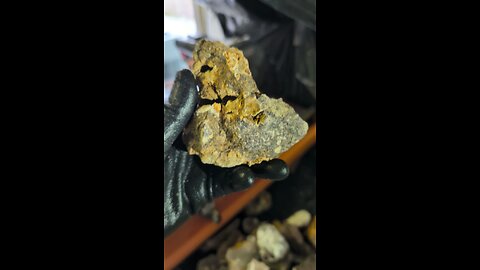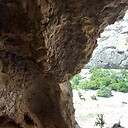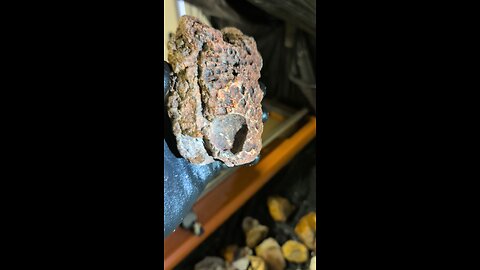
Chert!
2 videos
Updated 7 months ago
Chert is a hard, fine-grained sedimentary rock composed primarily of microcrystalline or cryptocrystalline silica. Here are some key points about chert:
Composition: Mostly silicon dioxide (SiO₂), which can appear in various forms like quartz, chalcedony, or opal.
Appearance: It can range in color from white to black, but it's commonly gray, brown, or red. It has a conchoidal fracture, meaning it breaks with smooth, curved surfaces similar to glass.
Formation: Chert can form in several ways:
Biogenic: From the accumulation of silica-rich remains of organisms like diatoms, radiolarians, or sponges.
Inorganic: Through the precipitation of silica from seawater or from the replacement of calcium carbonate in limestone (diagenetic chert).
Uses: Historically, chert was used by humans for making tools because of its hardness and ability to hold a sharp edge when knapped. Today, it's used in construction or as an abrasive due to its hardness.
Geological Context: Chert nodules or layers can be found in limestone or dolomite formations, and it's also common in banded iron formations.
Varieties: There are several named varieties of chert, including flint (a very high-quality chert), jasper (when it's red due to iron oxides), and novaculite (a dense form used for whetstones).
Chert's durability makes it an important rock in both archaeological and geological studies, providing insights into ancient environments and human history.
-
Chert Chunk!
 HumbleConservativeChert is a hard, fine-grained sedimentary rock composed mostly of microcrystalline quartz, which is a form of silica (SiO₂). Here are some key details about chert: Formation: Chert can form in several ways: Marine Environment: It often forms from the accumulation of microscopic silica organisms like diatoms or radiolarians in deep ocean environments, which later get compacted into rock. Chemical Precipitation: In some cases, chert forms through the direct precipitation of silica from water, either in marine or freshwater settings, filling cavities or replacing other materials. Replacement: Chert can replace carbonate rocks like limestone through a process known as silicification, where silica-rich fluids replace the original carbonate minerals. Composition: Primarily composed of microcrystalline quartz, chert might also contain minor amounts of other minerals like calcite, dolomite, or iron oxides, which can affect its color. Texture: Chert has a dense, fine-grained texture due to the very small size of the quartz crystals. It often has a smooth, sometimes waxy or glassy feel when polished. Color: Chert can be found in a variety of colors including white, gray, black, red, green, or brown. The color is influenced by impurities or the presence of other minerals. For example, iron oxides can give it a red or brown hue. Types: Flint: A type of chert that is often dark in color and found in chalk or marly limestone. Jasper: A red, yellow, brown, or green variety of chert, often with more iron content. Radiolarite: Chert rich in the remains of radiolarians, often found in deep-sea deposits. Bedded Chert: Layered chert found in sedimentary sequences. Uses: Tool Making: Historically, chert (especially flint) was extensively used by prehistoric peoples for making tools and weapons due to its hardness and ability to be finely chipped. Construction: When polished, chert can be used as a decorative stone in buildings or for flooring. Jewelry: Some varieties like jasper are used in jewelry due to their color and ability to take a polish. Geological Significance: Chert provides insights into ancient oceanic conditions, particularly the silica cycle. It can help geologists understand the chemical composition of ancient seas, the presence of silica-secreting organisms, and the processes of diagenesis and lithification.60 views
HumbleConservativeChert is a hard, fine-grained sedimentary rock composed mostly of microcrystalline quartz, which is a form of silica (SiO₂). Here are some key details about chert: Formation: Chert can form in several ways: Marine Environment: It often forms from the accumulation of microscopic silica organisms like diatoms or radiolarians in deep ocean environments, which later get compacted into rock. Chemical Precipitation: In some cases, chert forms through the direct precipitation of silica from water, either in marine or freshwater settings, filling cavities or replacing other materials. Replacement: Chert can replace carbonate rocks like limestone through a process known as silicification, where silica-rich fluids replace the original carbonate minerals. Composition: Primarily composed of microcrystalline quartz, chert might also contain minor amounts of other minerals like calcite, dolomite, or iron oxides, which can affect its color. Texture: Chert has a dense, fine-grained texture due to the very small size of the quartz crystals. It often has a smooth, sometimes waxy or glassy feel when polished. Color: Chert can be found in a variety of colors including white, gray, black, red, green, or brown. The color is influenced by impurities or the presence of other minerals. For example, iron oxides can give it a red or brown hue. Types: Flint: A type of chert that is often dark in color and found in chalk or marly limestone. Jasper: A red, yellow, brown, or green variety of chert, often with more iron content. Radiolarite: Chert rich in the remains of radiolarians, often found in deep-sea deposits. Bedded Chert: Layered chert found in sedimentary sequences. Uses: Tool Making: Historically, chert (especially flint) was extensively used by prehistoric peoples for making tools and weapons due to its hardness and ability to be finely chipped. Construction: When polished, chert can be used as a decorative stone in buildings or for flooring. Jewelry: Some varieties like jasper are used in jewelry due to their color and ability to take a polish. Geological Significance: Chert provides insights into ancient oceanic conditions, particularly the silica cycle. It can help geologists understand the chemical composition of ancient seas, the presence of silica-secreting organisms, and the processes of diagenesis and lithification.60 views -
Chert Chunk!
 HumbleConservativeChert is a hard, fine-grained sedimentary rock composed mostly of microcrystalline quartz, which is a form of silica (SiO₂). Here are some key details about chert: Formation: Chert can form in several ways: Marine Environment: It often forms from the accumulation of microscopic silica organisms like diatoms or radiolarians in deep ocean environments, which later get compacted into rock. Chemical Precipitation: In some cases, chert forms through the direct precipitation of silica from water, either in marine or freshwater settings, filling cavities or replacing other materials. Replacement: Chert can replace carbonate rocks like limestone through a process known as silicification, where silica-rich fluids replace the original carbonate minerals. Composition: Primarily composed of microcrystalline quartz, chert might also contain minor amounts of other minerals like calcite, dolomite, or iron oxides, which can affect its color. Texture: Chert has a dense, fine-grained texture due to the very small size of the quartz crystals. It often has a smooth, sometimes waxy or glassy feel when polished. Color: Chert can be found in a variety of colors including white, gray, black, red, green, or brown. The color is influenced by impurities or the presence of other minerals. For example, iron oxides can give it a red or brown hue. Types: Flint: A type of chert that is often dark in color and found in chalk or marly limestone. Jasper: A red, yellow, brown, or green variety of chert, often with more iron content. Radiolarite: Chert rich in the remains of radiolarians, often found in deep-sea deposits. Bedded Chert: Layered chert found in sedimentary sequences. Uses: Tool Making: Historically, chert (especially flint) was extensively used by prehistoric peoples for making tools and weapons due to its hardness and ability to be finely chipped. Construction: When polished, chert can be used as a decorative stone in buildings or for flooring. Jewelry: Some varieties like jasper are used in jewelry due to their color and ability to take a polish. Geological Significance: Chert provides insights into ancient oceanic conditions, particularly the silica cycle. It can help geologists understand the chemical composition of ancient seas, the presence of silica-secreting organisms, and the processes of diagenesis and lithification.59 views
HumbleConservativeChert is a hard, fine-grained sedimentary rock composed mostly of microcrystalline quartz, which is a form of silica (SiO₂). Here are some key details about chert: Formation: Chert can form in several ways: Marine Environment: It often forms from the accumulation of microscopic silica organisms like diatoms or radiolarians in deep ocean environments, which later get compacted into rock. Chemical Precipitation: In some cases, chert forms through the direct precipitation of silica from water, either in marine or freshwater settings, filling cavities or replacing other materials. Replacement: Chert can replace carbonate rocks like limestone through a process known as silicification, where silica-rich fluids replace the original carbonate minerals. Composition: Primarily composed of microcrystalline quartz, chert might also contain minor amounts of other minerals like calcite, dolomite, or iron oxides, which can affect its color. Texture: Chert has a dense, fine-grained texture due to the very small size of the quartz crystals. It often has a smooth, sometimes waxy or glassy feel when polished. Color: Chert can be found in a variety of colors including white, gray, black, red, green, or brown. The color is influenced by impurities or the presence of other minerals. For example, iron oxides can give it a red or brown hue. Types: Flint: A type of chert that is often dark in color and found in chalk or marly limestone. Jasper: A red, yellow, brown, or green variety of chert, often with more iron content. Radiolarite: Chert rich in the remains of radiolarians, often found in deep-sea deposits. Bedded Chert: Layered chert found in sedimentary sequences. Uses: Tool Making: Historically, chert (especially flint) was extensively used by prehistoric peoples for making tools and weapons due to its hardness and ability to be finely chipped. Construction: When polished, chert can be used as a decorative stone in buildings or for flooring. Jewelry: Some varieties like jasper are used in jewelry due to their color and ability to take a polish. Geological Significance: Chert provides insights into ancient oceanic conditions, particularly the silica cycle. It can help geologists understand the chemical composition of ancient seas, the presence of silica-secreting organisms, and the processes of diagenesis and lithification.59 views
